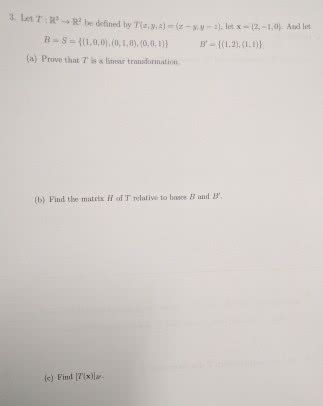K(x,y,z) = (x, x + y,x + y + z)
L(x,y,z) = (2x - y, x + 2y)
S(x,y,z) = (z,y,x)
T(x,y) = (2x + y,x + y,x - y,x - 2y)
G: R^3 -> M(2,2) defined by G(x,y,z) = (y z , (-x + y) -x)
H: M(2,2) -> P2 defined by H(a b, c d) = (a + b) + (a - 2d)x+ dx^2
Find the indicated linear transformation if it is defined. ifnot defined explain why it is not:
1) K + S
2) GS
3)2S^3 - S^2 + 3S - 4I
Find the matrix that represent each of the linear transformationK,L,S,and T for the following
1)TL
2)K + S
Find the matrix that represent each of linear transformation intwo ways, first using the result normal way and using therepresention of the matrix.
1)
T:R^3 --> R^4 given by T(X) = Ax, where
A = [1 1 0
2 0 3
-1 1 1
1 1 2]
and v1 = (-3,3,2) v2 = (0,0,0)
2) T: R^4 --> R given by T(x1,x2,x3,x4) = x1 + 2x2 + 3x3 +4x4 and v1 = (1,2,1,-2) v2 = (2,3,0,-2)
3)T: M(2,3) --> P2
P2 = (a11 + a13)x^2 + (a21 - a22)x + a23
v1 = [-1 3 1
2 2 0]
v2 = [2 1 -2
1 1 0]
& determine wheter w1 or w2 is the iamge of thecorresponding linear transformation
w1 = x^2 + 2x + 1,w2 = x - 2.
K(x,y,z) = (x, x + y,x + y + z)
L(x,y,z) = (2x - y, x + 2y)
S(x,y,z) = (z,y,x)
T(x,y) = (2x + y,x + y,x - y,x - 2y)
G: R^3 -> M(2,2) defined by G(x,y,z) = (y z , (-x + y) -x)
H: M(2,2) -> P2 defined by H(a b, c d) = (a + b) + (a - 2d)x+ dx^2
Find the indicated linear transformation if it is defined. ifnot defined explain why it is not:
1) K + S
2) GS
3)2S^3 - S^2 + 3S - 4I
Find the matrix that represent each of the linear transformationK,L,S,and T for the following
1)TL
2)K + S
Find the matrix that represent each of linear transformation intwo ways, first using the result normal way and using therepresention of the matrix.
1)
T:R^3 --> R^4 given by T(X) = Ax, where
A = [1 1 0
2 0 3
-1 1 1
1 1 2]
and v1 = (-3,3,2) v2 = (0,0,0)
2) T: R^4 --> R given by T(x1,x2,x3,x4) = x1 + 2x2 + 3x3 +4x4 and v1 = (1,2,1,-2) v2 = (2,3,0,-2)
3)T: M(2,3) --> P2
P2 = (a11 + a13)x^2 + (a21 - a22)x + a23
v1 = [-1 3 1
2 2 0]
v2 = [2 1 -2
1 1 0]
& determine wheter w1 or w2 is the iamge of thecorresponding linear transformation
w1 = x^2 + 2x + 1,w2 = x - 2.


